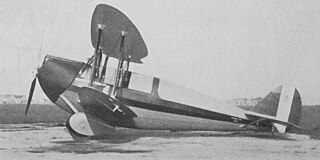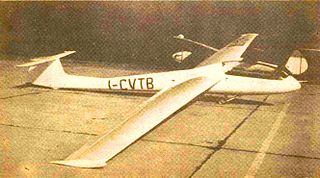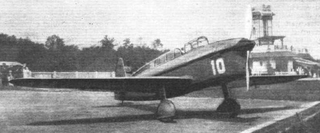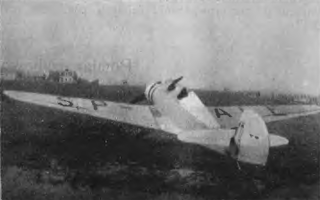
The Civilian Coupé is a British, single-engined two-seat private monoplane built starting in 1929. Only five were made and it was the Civilian Aircraft Company's only product, but one still flies in the UK.

The Robinson Redwing was a British two-seat single-engined biplane light aircraft built in the UK in 1930. Twelve were produced, selling mostly to Clubs; one aircraft survives.

The IAR-22 was a single engine basic trainer built in Romania in about 1934. It was a low-wing monoplane with two seats in tandem and a fixed conventional undercarriage.

The Granville Gee Bee R-6 International Super Sportster, named "Q.E.D.", and later named "Conquistador del Cielo", was the last in a series of racing and touring monoplane aircraft from the Granville Brothers. The R-6H was dogged with bad luck throughout its career and never finished any race it entered.

The Caproni Ca.125 was a single-engine, tandem two-seat, touring biplane built in Italy in 1933. It could be operated either as a landplane or seaplane.
The Caproni Sauro-1, or Caproni Tricap, was a light, single-engine cantilever monoplane, seating two in tandem, built in Italy in the early 1930s for touring. Despite good performance and favourable test reports, only one was built.
The Bonomi BS.14 Astore was a two-seat training and aerobatic glider, designed and built in Italy in 1935. Only one was constructed.
The Bonomi BS.15 Bigiarella, originally named the Bonomi BS.6 Bigiarella was a single seat glider, designed and built in Italy in 1934. Only three were constructed.
The Bonomi BS.18 Airone was a single seat training glider, designed in Italy in 1936. Only one was built.
The Caproni Vizzola MF and 2 were single-seat gliders built in Italy just before World War II. Intended as training aircraft capable of aerobatics, the two variants differed only in their fuselages. Only one of each was built, but they were both successful in Italian competitions.

The CVT2 Veltro was an Italian competition glider built in the mid-1950s. Its advanced design incorporated a laminar flow wing, T-tail, retracting undercarriage and a reclining seat to reduce parasitic drag.
The DFS Sperber Junior was a competition sailplane designed for Hanna Reitsch and built in Germany in 1936.

The Caudron C.530 Rafale was a French two seat competition aircraft. Only seven were built but they had great success in several contests during 1934.

The Caudron C.430 Rafale was a fast, two seat French touring monoplane. Soon after its first flight in 1933 it set an international class speed record.

The Caproni Ca.95 was a large, three engine, long range, heavy bomber prototype built in Italy in 1929. It could carry a 1,600 kg (3,500 lb) bomb load and had three defensive gun positions. Only one was built.
The Caproni Ca.66 was an Italian night bomber designed to reequip the post-World War I Italian Air Force. Only two examples of the four-engined biplane were built.

The Nowotny N-y 4bis was a tandem two-seat light aircraft, built in Poland, as a step towards a very light, low-powered training aircraft for flying clubs. Its designer was killed in a glider soon after the first flight of his trainer and its development was abandoned.

The Warsztaty Szybowcowe Sroka, or Kocjan Sroka after its designer, was a Polish intermediate training glider. About sixty were built between 1934 and 1939.
The Caproni Ca.66 and Caproni Ca.67 were Italian night bomber aircraft designed to re-equip the post-World War I Regia Aeronautica.

The Caproni Ca.53 was an Italian prototype light bomber built in the last months of World War I.












